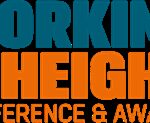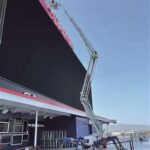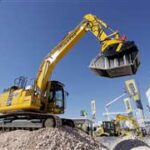Imagine this:
You’re on a construction site.
The ground looks like a teenager’s first attempt at making pancakes—bumpy, cracked, unpredictable.
You need to lift people 60 feet in the air.
“Can my boom lift handle this mess?”
Good news: Some boom lifts are built for exactly this challenge.
Bad news: Not all of them are.
Let’s break it down so you don’t end up stuck, tilted, or tipping over.
🚧 Why Uneven Ground Is a Big Deal
Boom lifts are precision machines.
They expect the world underneath them to behave.
When it doesn’t (thanks, potholes and jobsite chaos):
-
The center of gravity shifts dangerously.
-
Tires lose full contact with the ground.
-
Load balance becomes unpredictable.
-
Risk of tip-overs skyrockets.
That’s why choosing the right boom lift for uneven ground isn’t just smart—it’s survival.
⚙️ Boom Lift Features That Handle Rough Terrain
✅ 4WD (Four-Wheel Drive)
All four wheels powered = way better traction.
✅ Oscillating Axles
The axles adjust independently to stay grounded when the terrain gets weird.
✅ Rough Terrain Tires
Bigger, thicker, deeply treaded tires designed for dirt, gravel, mud, and rocks.
✅ High Ground Clearance
Helps the boom lift roll over obstacles without getting stuck like a turtle.
✅ Tilt Sensors
Modern lifts have alarms and auto-lockouts when slope limits are exceeded.
✅ Outriggers or Stabilizers (for some models)
Deployable supports that create a bigger, more stable footprint.
📋 Popular Rough Terrain Boom Lift Models
| Model | Key Features |
|---|---|
| Genie S-65 XC | 4WD, oscillating axles, diesel power |
| JLG 800AJ | 4WD, rough terrain tires, high outreach |
| Dingli BT44ERT | 4WD, modular design, electric rough-terrain drive |
| Haulotte HA41 RTJ PRO | High ground clearance, powerful diesel drive |
These beasts don’t blink at mud, rocks, or half-finished job sites.
🛠️ Pro Tips for Working on Uneven Ground
✅ Inspect first.
Walk the route. Spot soft patches, trenches, hidden slopes.
✅ Level the machine if possible.
Use built-in leveling systems or manual adjustments before lifting.
✅ Don’t exceed slope limits.
Typical safe slopes: 3°–5° while elevated, up to 40% gradeability for driving unraised.
✅ Move slow and steady.
This isn’t a rally race.
Low speeds = higher stability.
✅ Use mats or cribbing if needed.
Temporary ground improvement helps on soft or shifting surfaces.
✅ Lower the boom if repositioning.
Don’t drive long distances at full height across bad ground.
❌ What Happens If You Ignore the Rules?
-
Platform instability = swinging workers = risk of falls.
-
Mechanical strain = premature equipment failure.
-
Worst case: complete tip-over.
A 10,000-lb machine flipping over is not a small accident.
It’s a full-blown emergency—and sometimes, a tragedy.
💬 Quick FAQ
Q: Can electric boom lifts handle rough terrain?
✅ Some newer models can—especially hybrid models like Genie’s FE series and Dingli’s BT44ERT.
But check specs: not every electric lift is rough-terrain ready.
Q: Can you use outrigger pads?
✅ Definitely. Spread the load, especially on soft dirt or sand.
Q: What if the ground is wet/muddy?
✅ Assess carefully. Wet soil can look “hard” but act like quicksand once you load it.
🏁 Final Thoughts
Can a boom lift work on uneven ground?
👉 Yes—but only if it’s built for it.
👉 And only if you respect the ground, the limits, and the machine.
Rough terrain boom lifts are engineering marvels—but they’re not magic carpets.
Plan your moves. Pick the right lift. Adjust for the real-world conditions under your wheels.
Because when you’re 60 feet up…
you want solid support under your boots—not wishful thinking.




